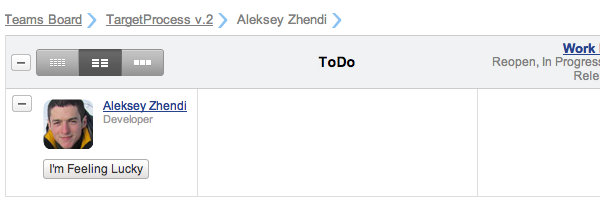How we are working
Today we want to open the veil and talk about a few secret practices of our company . We are making TargetProcess flexible project management system. We hope that practices will help you understand our values and vision better.
We have a special role as a caretaker for functional tests. The role rotates, different people are responsible for the tests every day. A person in this role improves green tests and comments on red ones. Tests become better and more stable over time.
To denote the developer’s SFUT, we have a cat. The cat sits on the table near the SFUT all day and smiles.

During the daily meeting, the cat is transferred from one developer to the next on the list.

Every day at 11 am we have a stand-up meeting. It usually takes no more than 15 * Π minutes for 15 people. Throughout the year, we measured the time of the meeting and found that most people spend 3.14 minutes describing yesterday’s and today's affairs.
Current progress is displayed on the big screen:

Developers with the lowest individual productivity over the past week are assigned to the most complex bugs. Practice has shown that this is a great way to increase the productivity of the entire team, no one wants to deal with complex bugs and everyone is trying to work harder to avoid such a sad fate.
We used to have boring and long meetings to prioritize work. It turned out that statistical estimation of priorities is much more effective than human. We have developed an extremely complex prioritization algorithm based on Gödel’s incompleteness theorem and Bayesian probability. The algorithm works surprisingly for sure!
The user interface is extremely simple. The OUNER product clicks on the button before the release planning meeting, and that’s it! We can only discuss the user story.

We are starting to think about removing the Product Owner role from the team. Statistics (we love statistics very much) shows that there is practically no dependence on who presses the prioritization button.
Automatic evaluation algorithmThe user is also on the way. We have tested the basic concepts and hope to include it in the next release of our system . This will save a lot of time for thousands of teams around the world!
The usual way to assign work is pretty boring. We are always looking for ways to make everything more fun. Now each developer can quickly and easily take on an interesting task:

We believe in bootstrapping. Our company has grown without any external investment. We hire people who share our vision. We are doing everything to create true Spartan conditions. This is what a typical developer workstation looks like:

We really appreciate learning and make people learn as best we can. For example, Sergey is sitting here. He read a stack of books on the right over the past week. He is obliged to read a stack of books on the left for the remaining 3 weeks this month. On average, each developer reads 100 books a year.

We hope that some of our practices will seem useful to you and will increase theyield of valuable resources of people in your company.
Functional Test Supervisor (SFC)
We have a special role as a caretaker for functional tests. The role rotates, different people are responsible for the tests every day. A person in this role improves green tests and comments on red ones. Tests become better and more stable over time.
To denote the developer’s SFUT, we have a cat. The cat sits on the table near the SFUT all day and smiles.

During the daily meeting, the cat is transferred from one developer to the next on the list.

Daily meetings
Every day at 11 am we have a stand-up meeting. It usually takes no more than 15 * Π minutes for 15 people. Throughout the year, we measured the time of the meeting and found that most people spend 3.14 minutes describing yesterday’s and today's affairs.
Current progress is displayed on the big screen:

Developers with the lowest individual productivity over the past week are assigned to the most complex bugs. Practice has shown that this is a great way to increase the productivity of the entire team, no one wants to deal with complex bugs and everyone is trying to work harder to avoid such a sad fate.
Priorities and performance evaluation
We used to have boring and long meetings to prioritize work. It turned out that statistical estimation of priorities is much more effective than human. We have developed an extremely complex prioritization algorithm based on Gödel’s incompleteness theorem and Bayesian probability. The algorithm works surprisingly for sure!
The user interface is extremely simple. The OUNER product clicks on the button before the release planning meeting, and that’s it! We can only discuss the user story.

We are starting to think about removing the Product Owner role from the team. Statistics (we love statistics very much) shows that there is practically no dependence on who presses the prioritization button.
Automatic evaluation algorithmThe user is also on the way. We have tested the basic concepts and hope to include it in the next release of our system . This will save a lot of time for thousands of teams around the world!
Cool appointments
The usual way to assign work is pretty boring. We are always looking for ways to make everything more fun. Now each developer can quickly and easily take on an interesting task:

Workplaces
We believe in bootstrapping. Our company has grown without any external investment. We hire people who share our vision. We are doing everything to create true Spartan conditions. This is what a typical developer workstation looks like:

Education
We really appreciate learning and make people learn as best we can. For example, Sergey is sitting here. He read a stack of books on the right over the past week. He is obliged to read a stack of books on the left for the remaining 3 weeks this month. On average, each developer reads 100 books a year.

We hope that some of our practices will seem useful to you and will increase the
